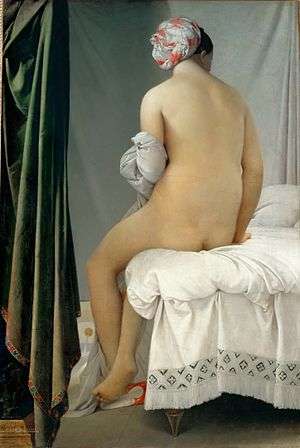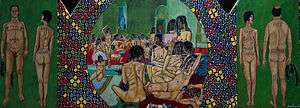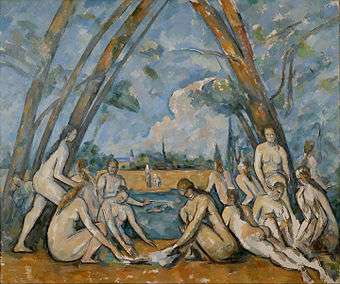The Turkish Bath

The Turkish Bath (Le Bain Turc) is an oil painting by Jean-Auguste-Dominique Ingres. It depicts a group of nude women in the bath of a harem, and is painted in a highly erotic style that evokes both the near east and earlier western styles associated with mythological subject matter. Painted on canvas laid down on wood, it measures 108 x 108 cm. The work is signed and dated 1862, when Ingres was around 82 years old, and was completed in 1863.[1] In that year Ingres altered the painting's original rectangular format, and cut the painting to its present tondo form. Photographs of the painting in its original format survive.[2] It seems based on an April 1717 written description of a Turkish harem by Lady Mary Montagu,[3] where she mentions having viewed some two hundred nude women.[1] The painting develops and elaborates a number of motifs Ingres had explored in earlier paintings, in particular his 1808 The Valpinçon Bather and Grande Odalisque of 1814.
Its erotic content did not provoke a scandal, since for much its existence it has remained in private collections. It is now in the Louvre, Paris.
Description


The painting is known for its subtle colourisation, especially the very pale skin of the women resting in the privacy of a bathing area. The figures are given an almost abstract and "slender and sinuous" form, and seem at times to lack skeleton. They are arranged and a very harmonious, circular manner; a curved arrangement that heightens the erotism of the painting. Its charge is in part achieved through the use of motifs that include the implied haze of Oriental perfume, and the inclusion of vases, running water, fruit and jewels, as well as a palette than ranges from pale white to pink, ivory, light greys and a variety of browns.[3]
Ingres relished the irony of producing an erotic work in his old age, painting an inscription of his age (AETATIS LXXXII, "at age 82") on the work – in 1867 he told others that he still retained "all the fire of a man of thirty years".[4][5] He did not paint this work from live models, but from croquis and several of his earlier paintings, reusing 'bather' and 'odalisque' figures he had drawn or painted as single figures on beds or beside a bath.
The figure from his The Valpinçon Bather appears almost identically as the central element of the later composition, but now plays a mandolin. The woman in the background with her arm extended and holding a cup of coffee resembles the sitter in his 1856 portrait of Marie-Clotilde-Inès Moitessier. The face of the woman with her arms raised above her head in the near right is similar to an 1818 croquis of the artist's wife, Delphine Ramel,[2] though her right shoulder is lowered whereas her right arm is raised (an anatomical inconsistency usual in Ingres's work – La Grande Odalisque has three additional vertebrae). The other bodies are juxtaposed in various unlit areas behind them.
Ingres's draws from a wide variety of painterly sources, including 19th-century academic art, Neoclassicism and late Mannerism. While at first look the painting might seem like a corporeal descent into wild abandon, it is in actuality very still, precise and geometrical throughout. The colourisation is one of "chastising coolness", while figures merge into each other in a manner that evokes sexuality, but ultimately is intended to show his skill at defying rational perspective Ingres invokes a setting that is both very real and only imaginary.[2]
Influence

Ingres was influenced by the then fashion for Orientalist, re-launched by Napoleon's invasion of Egypt. On leaving for Italy in 1806, he copied in his notebooks a text extolling 'the baths of the seraglio of Mohammed', in which can be read a description of a harem where one "goes into a room surrounded by sofas [...] and it is there that many women destined for this use attend the sultana in the bath, wiping her handsome body and rubbing the softest perfumes into her skin; it is there that she must then take a voluptuous rest".[4][6]

In 1825, he copied a passage from Letters from the Orient by Lady Mary Montagu, who had accompanied her British diplomat husband to the Ottoman Empire in 1716. Her letters had been re-published eight times in France alone between 1763 and 1857, adding to the Orientalist craze there. The passage Ingres copied was entitled "Description of the women's bath at Adrianople" and reads: "I believe there were two hundred women there in all. Beautiful naked women in various poses... some conversing, others at their work, others drinking coffee or tasting a sorbet, and many stretched out nonchalantly, whilst their slaves (generally ravishing girls of 17 or 18 years) plaited their hair in fantastical shapes."[4][7]

In contrast to Delacroix (who visited an Algerian harem), Ingres never travelled to Africa or the Middle East, and the courtesans shown are more Caucasian and European than Middle Eastern or African in appearance. For Ingres the oriental theme was above all a pretext for portraying the female nude in a passive and sexual context. Exotic elements are few and far between in the image: musical instruments, a censer and a few ornaments.
Provenance
The painter's first buyer was a relation of Napoleon III, but he handed it back some days later, his wife having found it "unsuitable" ("peu convenable").[8] It was finally bought in 1865 by Khalil Bey, a former Turkish diplomat who added it to his collection of erotic paintings.
Edgar Degas demanded that The Turkish Bath be shown at the exposition universelle, in the wake of which came contrasting reactions – Paul Claudel compared it with a "cake full of maggots".[8] At the start of the 20th century, patrons wished to offer The Turkish Bath to the Louvre, but the Louvre's council refused it twice. After the national collections of Munich offered to buy it the Louvre finally accepted it in 1911, thanks to a gift by the Société des Amis du Louvre, to whom the patron Maurice Fenaille made a 3-year interest-free loan of 150,000 Francs for the purpose.
Legacy

References
Bibliography
- D'Souza, Aruna. Cezanne's Bathers: Biography and the Erotics of Paint. Pennsylvania State University Press, 2008. ISBN 978-0-2710-3214-6
- Montagu, Mary. L'islam au péril des femmes, une Anglaise en Turquie au XVIIe siècle. Paris 1981
- Magi, Giovanna. The Grand Louvre and the Musee D'Orsay. Casa Editrice Bonechi, 1998. ISBN 978-8-8700-9780-1
- Pach, Walter. Ingres. New York, 1973
- Hagen, Rose-Marie; Hagen, Rainer. Les dessous des chefs-d'œuvre. Köln: Taschen 2000. 410-415
- Rosenblum, Robert. "Ingres's Portraits and their Muses". In: Tinterow, Gary; Conisbee, Philip (eds). Portraits by Ingres: Image of an Epoch. New York: Metropolitan Museum of Art, 1999. ISBN 978-0-3000-8653-9
- Toussaint, Hélène. Catalogue de l'exposition du Louvre : Le Bain Turc d'Ingres. Paris, 1971
External links
- The Turkish Bath Analysis
- Un rêve oriental (French) by Michel Makarius, on le Musée critique de la Sorbonne
- A virtual exhibition about bathing in art, from Cranach to Fellini

_-_Zelfportret_(1864)_-_28-02-2010_13-37-05.jpg)